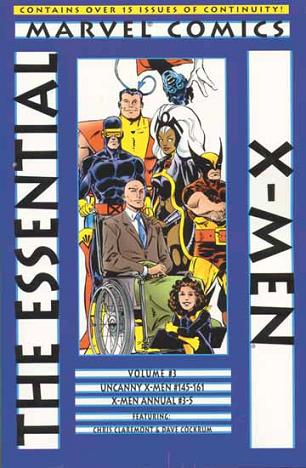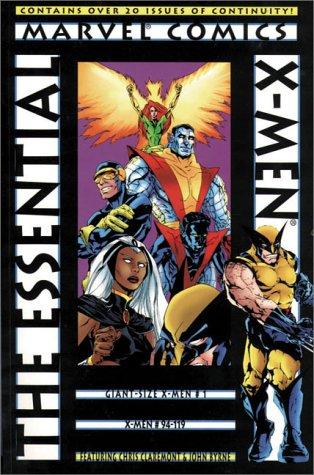
Essential X-Men Vol. 4
Chris Claremont, Dave Cockrum, Paul Smith, John Romita Jr and friends
Reprints: Uncanny X-Men #162-179, Annual #7, Marvel Graphic Novel #5 (October 1982 – March 1984)
Get this for: full blown mutant paranoia with the X-Men — four stars
The fourth volume of Essential X-Men starts with the tail end of Dave Cockrum’s second run on the title, and the Brood Saga. At the end of the previous volume the X-Men had been kidnapped into space, this volume opens with Wolverine discovering where they were: on the home planet of the Brood, Marvel’s very own Alien knockoff. On the run from them, lost and alone in a very hostile alien jungle Wolvie discovers things are even worse than he thought, as it turns out he and the other X-Men have been impregnated by the Brood Queen and are carrying an alien embryo. They’ll die giving birth to new queens but not before they might be able to hurt the Brood. It’s another X-Men space epic, but a much more depressive one than the previous ones.
It sets the tone for the rest of this volume, as the X-Men’s world gets progressively darker. After the Brood Saga and its aftermath, the next story is from Marvel Graphic Novel #5, “X-Men: God Loves, Man Kills”, which after “Days of Future Past” is the first story explicitely about mutant hatred. It’s not a good story, with the subtely of a sledgehammer and very eighties with its televangelist villain, but it’s a prelude of what’s to come. Though this had supposedly always been the theme of The X-Men, for the most part the classic X-Men had been a regular superhero title and mutant hatred even with Claremont at the helm it took to “Days of Future Past” in #141-142 that it became explicit. But while that story showed the nightmare future the X-Men fought again, it still wasn’t a big part of the series afterwards. With the graphic novel Claremont put mutant phobia in the spotlights again and in the regular title as well it became more prominent, as the X-Men became more and more mistrusted by the world they had saved so often
For example, even in the lighthearted story from Annual 7 this mistrust is shown. The Impossible Man, an old Fantastic Four villain, is on a scavenger hunt taking trophies from all his favourite superheros: the X-Men’s mansion, Nick Fury’s eye patch and the Wasp’s entire collection of costumes, with the X-Men chasing after him. When Rogue and Colossus follow him to the Avengers’ Mansion, they’re attacked by She-Hulk and Iron Man who mistake them for the thieves. It’s one small example of the mistrust between our favourite muties and the rest of the superhero community.
Another big change for the X-Men is that they’re no longer the only mutant team: while they were kidnapped by the Brood, Charles Xavier had assembled a team of New Mutants. It showed how popular the X-Men had become that there was now a second mutant title. It’s not immediately notable in the X-Men’s own title, except for the inevitable confrontation when they return from outer space.
Apart from the ongoing mutant paranoia, Claremont also heaps more personal troubles on his heroes. The X-Men and especially Storm start to change again during the Brood Saga, as they have to fight for their lives and kill as well. On Earth too they have to become harder, lose some of their idealism to survive. With Storm, always portrayed as an innocent abroad, this change hits hardest: in issue 170 she actually strikes to kill an opponent, Callisto of the Morlocks who had kidnapped the Angel to be her consort. She fights a knife duel with Callisto, the latter seems to have her on the ropes, but Storm manages to tangle Callisto’s arm in her cape and stabs her full in the heart. This moment is shown in a great six panel sequence by Paul Smith, the upper left panel showing Storm and Callisto as Storm prepares to strike, then a close up from behind Storm’s shoulder showing the expression on Callisto’s face as she’s stabbed in the chest. The third panel then shows them standing, Callisto starting to collapse. The bottom three panels has Storm walking to the camera, past Callisto falling down and with the Morlock crowd in the background. A great sequence and a example of Paul Smith’s talent.
Storm’s change into somebody much more harder, less naive (as symbolised by her new, street tough costume in #173) is not the only angst the X-Men go through. Wolverine sees his marriage to Lady Mariko Yashida fall through at the last moment, Mariko being manipulated by Mastermind, who’s back for vengeance. Even after this is cleared up Wolvie doesn’t get to marry his great love, as Mariko’s family is entangled with the Yakuza again and she feels her duty compels her to clean this up first. But all this is just collatoral damage in Mastermind’s real plot: to convince the X-Men Dark Phoenix is back and get them to kill an innocent woman.
Because on the last page of #168 Madeleine Pryor is introduced to Scott Summers and she is a dead ringer (no pun intended) for Jean Grey, his one true love who had killed herself rather than give in to the temptation to become Dark Phoenix again. Scott falls hard for Madeleine, with the next issue finding them slow dancing together, even though he had spent most of #168 being intimate with his previous girlfriend, Lee Forrester. Madeleine and Scott seem made for each other, but he cannot help but wonder… He finally asks the question he dreads, whether she is Phoenix and is answered by an energy blast. Issue 175 finds the X-Men fighting for their lives against a reborn Phoenix, or so things seem, but Scott finally figures things out and then has to fight for his life against the rest of the X-Men who are now convinced he‘s Phoenix… It all works out in the end, with a wedding for Maddy and Scott, but it was a long hard slog.
The third angst generator is the coming of Rogue, their old adversary from the Brotherhood of Evil Mutants, who was the one who robbed Carol Danvers from her powers, memories and almost her life. She joins the X-Men out of desperation, with her powers out of control and confused about who she is thanks to Carol’s personality being entangled with her own. Xavier lets her joint against the wishes of most X-Men, who slowly have to learn to live with her. It’s a good example of Claremont’s great skill at soap opera and how he can manipulate his readers. It makes perfect sense for the X-Men to take in Rogue, with their mission of rehabilitation, but I’m sure many readers would’ve been as outraged as Carol at the unfariness of it all when she learned of it…
A quick word about the art to finish this off. As said, this volume starts with Dave Cockrum doing his usual excellent job, who is replaced by Paul Smith, then a complete unknown but who is just as good as Cockrum from the start. He has a smooth, semi-realistic style that’s sort of reminds me of Alan Davis, but not quite and he’s great at depicting subtle emotions with just a few lines. Smith in turn is replaced by John Romita Jr., who continues in his style but puts a slightly scratchier edge on it. All three artists work well with Claremont, who adapts himself in turn to each of them. A great volume again.

